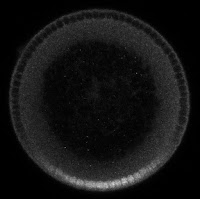We have recently put a manuscript on bioRxiv:
A Facilitated Diffusion Mechanism Establishes the Drosophila Dorsal Gradient http://biorxiv.org/content/early/2016/06/03/057091
In our manuscript, we have found that the Dorsal gradient is, at least in part, established by a facilitated diffusion mechanism. This is a way that the Dorsal protein can fight against its concentration gradient and accumulate on the ventral side of the embryo. Without this, the Dorsal gradient likely would not get "tall" enough to specify all of the necessary genes, such as snail.
If you haven't checked out bioRxiv, it is the preprint server for
biology hosted by Cold Spring Harbor Laboratory. This is where
researchers will post their findings before they get officially
published in a peer-reviewed journal.
Wednesday, June 8, 2016
Thursday, January 14, 2016
How cells in a fruit fly embryo know what to do
Our favorite morphogen system is the dorsal-ventral (DV) axis specification in the Drosophila melanogaster (fruit fly) embryo. In this system, a protein called "Dorsal" has a high concentration (in the nucleus) on the ventral side of the embryo and a low concentration on the dorsal side. (By the way, if you're wondering why it seems the name is backwards -- why is Dorsal absent on the dorsal side, but present on the ventral side? -- you might want to read our post here.) It also directs the cells along the DV axis to express different genes, in a concentration dependent fashion. So Dorsal acts as a morphogen.
If you read our post introducing the idea of a morphogen, you know that the typical way a morphogen concentration gradient forms is by a small set of cells producing the protein, then diffusion causes the concentration of that protein to spread out. This is not the case with Dorsal. It is present everywhere, but cannot act because it's bound to an inhibitor protein called Cactus. (Yes, seriously, it's called Cactus. Again, you might want to read about why fruit fly gene names are so weird.)
But, on the ventral side of the embryo, a signal from the receptor Toll causes Cactus to be degraded, which releases Dorsal, allowing it to go into the nucleus and direct gene expression (see the above figure). This "Dorsal nuclear concentration gradient" (see figure below) is one of the earliest signals to direct the cells in the fly embryo to differentiate into different types, specifying (from ventral to dorsal) muscle, neuron, skin, and an extraembryoinc tissue called the amnioserosa. So the Dorsal gradient is very important, and is one of the more well-studied morphogen systems.
If you read our post introducing the idea of a morphogen, you know that the typical way a morphogen concentration gradient forms is by a small set of cells producing the protein, then diffusion causes the concentration of that protein to spread out. This is not the case with Dorsal. It is present everywhere, but cannot act because it's bound to an inhibitor protein called Cactus. (Yes, seriously, it's called Cactus. Again, you might want to read about why fruit fly gene names are so weird.)
But, on the ventral side of the embryo, a signal from the receptor Toll causes Cactus to be degraded, which releases Dorsal, allowing it to go into the nucleus and direct gene expression (see the above figure). This "Dorsal nuclear concentration gradient" (see figure below) is one of the earliest signals to direct the cells in the fly embryo to differentiate into different types, specifying (from ventral to dorsal) muscle, neuron, skin, and an extraembryoinc tissue called the amnioserosa. So the Dorsal gradient is very important, and is one of the more well-studied morphogen systems.
Subscribe to:
Comments (Atom)

